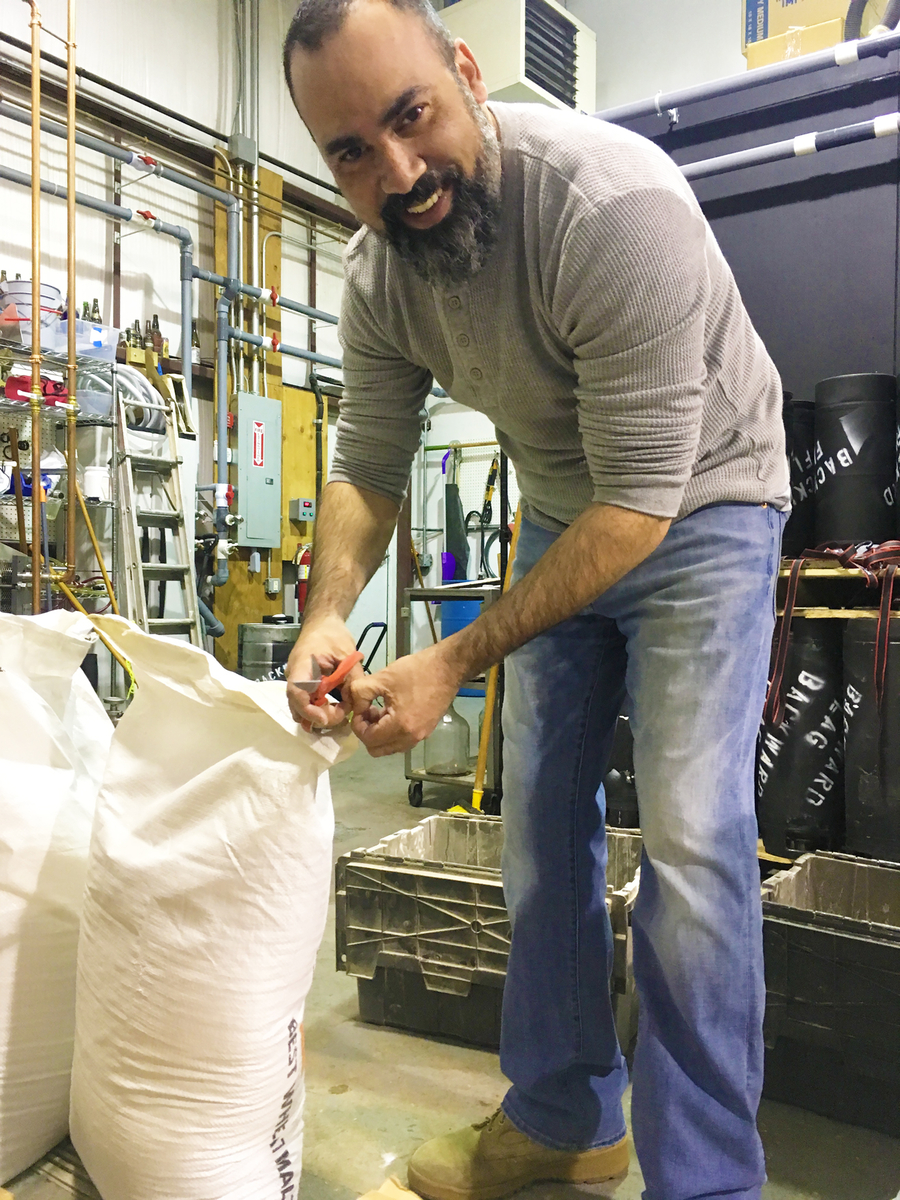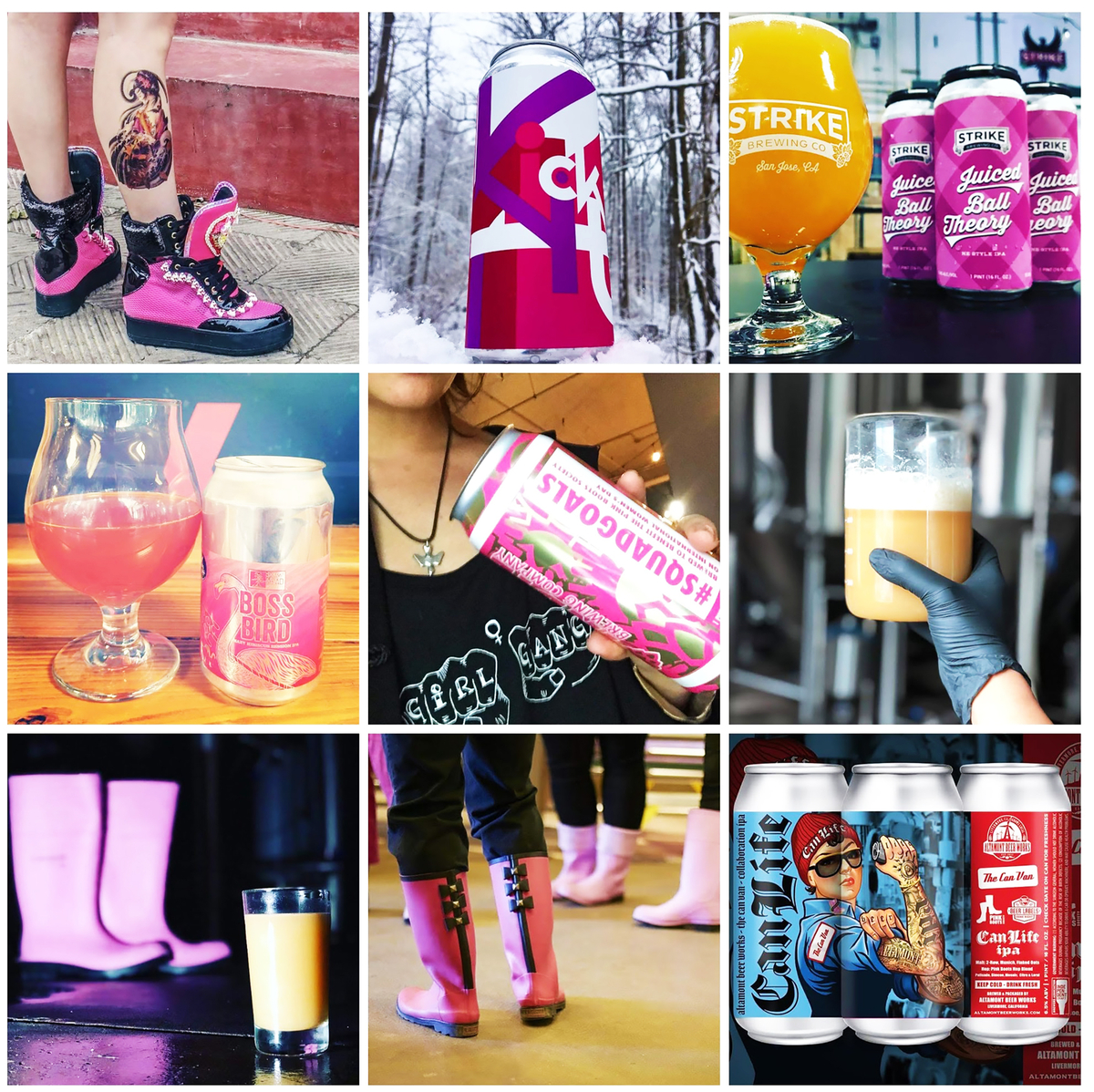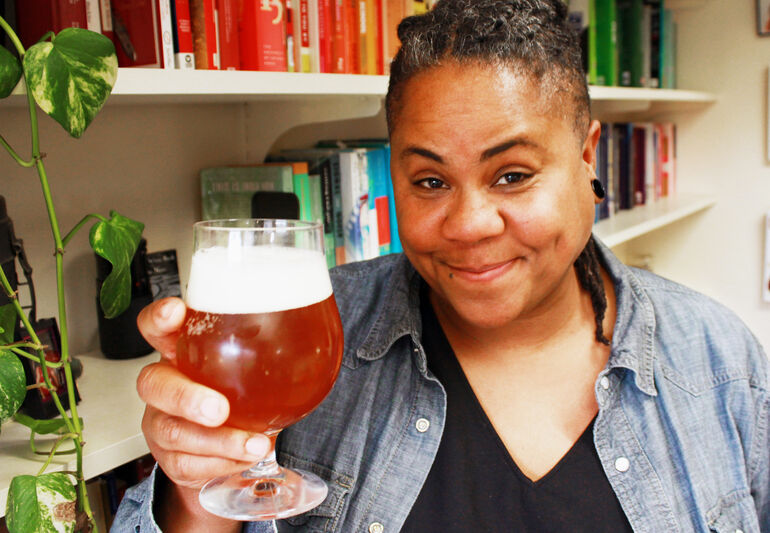Start 14-Day Trial Subscription
*No credit card required

The Stunning Lack of Diversity in Craft Brewing
Craft beer is the biggest it's ever been, with incredible stylistic diversity and a wealth of fascinating flavors and aromas available to be discovered. With that in mind, why is that same diversity not represented among those who actually make the beer?
Let’s begin with a test. It’s one that Grace Weitz, marketing manager at Hop Culture and founder of the Beers With(out) Beards festival, likes to put forward to as many craft beer drinkers as she can.
Close your eyes and think of the last beer you drank or grab one now and follow along. What are its characteristics? How does it taste, smell, feel? Now, with eyes still closed, try to imagine what the person who might have made this beer looks like.
“Do they appear short? Tall? Big? Small? Blond hair and blue eyes?” asks Weitz. “I’d wager nine times out of 10, your average craft beer drinker pictures a burly man with a robust beard.”
This simple experiment illustrates what she says is a significant barrier for many women seeking to enter and succeed in the industry.
“People’s perceptions of how a brewer should look set women back a few feet,” says Weitz. “Let me be clear, everyone puts hard work into this industry – both male and female brewers – but out front in the public eye, women need to exert twice the amount of effort to establish themselves.”
This bias, whether implicit or explicit, is not just limited to women in brewing. It’s also about the lack of diversity across the board – in brewing, distributing, marketing, writing about and selling craft beer – when it comes to race/ethnicity, able-bodied/disabled, age, and other (including unperceived) identifiers.

“People’s perceptions of how a brewer should look set women back a few feet,” says Grace Weitz, founder of the Beers With(out) Beards festival. “Let me be clear, everyone puts hard work into this industry – both male and female brewers – but out front in the public eye, women need to exert twice the amount of effort to establish themselves.”
Photo Courtesy Pink Boots Society
What the Numbers Reveal
There is a wealth of data available about the beer industry, thanks to organizations like the Brewers Association, Beer Marketer’s Insights, the National Beer Wholesalers Association and others.
This data shows how much beer was made, where it was sold, what beer styles did well last quarter, and, to a fairly detailed degree, who consumed it. This is valuable information for anyone in the brewing industry, but what is close to nonexistent is hard data about who made that beer.
What data the industry does have can help make a case for collecting what’s missing. For example, in 2016 the Brewers Association published highlights from a U.S. Yankelovich MONITOR survey of more than 10,000 consumers showing that more millennials, women and Hispanics are enjoying craft beer. At that time, 25 percent of women identified as weekly craft beer drinkers and 21 percent of Hispanics were weekly craft beer drinkers.
The Brewers Association updated its findings in June 2018 with a report by Nielsen Harris on Demand that states the number of women who drink craft “at least several times a year” rose to 31.5 percent, equaling about 6.6 million “new” women drinkers since 2015 (the report equates drinking several times a year to several times a month).
In fact, women are actually a majority of craft drinkers in a handful of cities according to the same Nielsen report. At the top of the list is Portland, Oregon, with 52.7 percent of craft beer drinkers being women; Providence, Rhode Island, is nearly identical with 52.6 percent.
The 2018 findings also showed that minority craft drinkers are increasing ‒ but only because the total population of craft drinkers is growing, not as a percentage.
Lopez Negrete Communications, a Houston-based Hispanic marketing firm, released a study in 2017 showing 49 percent of adult Hispanics drink beer. While there is a preference shown toward import beers, the data indicated that 54 percent of Hispanics would drink craft beer if they knew more about it.
“The way to crack that market,” says Gerry Loredo, who helped lead the study, involves “the places where younger Hispanics can participate in the process. If we were to do a 2.0 version of our study, we would look specifically at how many Hispanics own and run craft breweries.”
Loredo is eagerly awaiting the latest data to be released that would give him a foundation for his updated study. That information comes through the Economic Census, which is completed every five years. The 2017 Census data is has not yet been released, so all there is to look at is data from 2012, which showed that of the 1,034 breweries (NAICS Code 312120) who responded to the Census, two were owned by African-Americans, 15 by Hispanics, 36 by Asians and 972 by Whites.
On a national scale, Hispanics are projected to account for nearly 20 percent of workers in the U.S. by 2024, up from 9 percent in 1994, according to the Bureau of Labor Statistics.
It’s not that hard to identify who drinks craft beer, and it’s clear that the demographics are shifting. The real question is, where is diversity represented throughout all other areas of the craft beer industry – especially among those who actually produce the beer?
One report from 2014 is among the most frequently cited dataset that covers women in brewing. The Auburn University study showed 29 percent of brewery workers were female and only 17 percent of breweries (349 at the time) had female CEOs. Of those breweries, only 3 percent (67), had a solo female CEO. The rest were co-CEOs with a male, such as a husband/wife team. Only 4 percent of breweries (76) had a female head brewer, and only 2 percent (38) had exclusively female brewers.
In that very small percentage of breweries run by women is Bev Armstrong, founder of Brazo Fuerte Artisanal Beer. When she opened her brewery in Watertown, Massachusetts, in 2016, it was the first female-owned brewery in the state, the first brewery owned by an African-American in the state, and only the second brewery owned by an African-American female in the United States (the first was Harlem Brewing Co. founded by Celeste Beatty in New York in 2000).
“There is an obvious lack of diversity in the beer industry across the many ways that you can define diversity,” says Armstrong. “Some beer companies care and are finding ways to fix it. Some beer companies care, but don’t know how to fix it. Many other beer companies don’t care.”

Grassroots Efforts
Data is information about where things are and where they came from. Nothing can show, with certainty, where things are going. For that, one must look at the people and organizations who are trying to push the industry forward into an inclusive future.
On the list of events that are already making strides toward inclusivity is the above-mentioned Beers With(out) Beards festival, being held August 7-12, 2018 in Brooklyn, New York. The festival part features 20+ women-owned breweries or breweries helmed by female brewers. Other events of note include the FemAle Brew Fest in South Florida and Betty’s Beer Fest in Vermont.
Of those breweries who care about the lack of diversity and are actively doing something about it, Bev Armstrong cited The Boston Beer Co. She was assisted by the company through its Brewing the American Dream program, one which put Armstrong alongside Jim Koch, who helped her shape her business model. This kind of mentorship can benefit those entrepreneurs who have a passion for craft beer but lack real-world experience or connections ‒ including women, minorities and those who don’t see themselves well represented in the industry. Today, Armstrong’s products are sold in bars, restaurants, and retail stores in the greater Boston area.
As of now, stories like hers are few and far between. But recognizing this disparity may help the industry move toward addressing it, including pushing for legislation that benefits entrepreneurs of all stripes.
Take the state of Georgia as a recent example. It now has 66 breweries, up 20 percent in the last year alone due to the passing (at long last) of a law to allow direct-to-consumer sales from a brewery. The previous law was viewed as prohibitive, scaring off would-be brewers who were concerned about generating enough revenue to sustain a new business.
Only this year did Georgia see the opening of the state’s first brewery solely owned by African-Americans, Down Home Brewing. According to the 2010 U.S. Census, African-Americans make up 31.4 percent of Georgia’s population, the fourth-highest percentage for a U.S. state.
Business-friendly environments, along with programs like Brewing the American Dream that help mentor newcomers, could open the door to greater diversity in Georgia and beyond.
Taking accessibility into consideration also could greatly expand access within the industry and among consumers. For example, Brewability Lab in Denver both employs adults with special needs and provides an environment that welcomes all. It was founded in October 2016 by Tiffany Fixter, a former special needs elementary teacher who moved to the city to work for adult day programs.
“When you reach 21 there’s not a lot of choices for those with special needs,” says Fixter. “I wasn’t impressed with the day programs I saw. So many people have much more talent and skills than they get credit for, and people don’t always buy yarn dolls or other crafts, so I wanted to start something that people actually want to buy. There’s nothing hotter than beer in Denver, aside from marijuana.”
Fixter found a turnkey brewery in northeast Denver and went to work. Since opening, the brewery has kept nearly all its original employees, most who have Asperger’s or fall somewhere on the autistic spectrum. Except Alex Randall.
“Alex will tell you he’s the best blind bartender in the world,” says Fixter. Alex can pour any beer ordered because of two systems in place at Brewability Lab. One is the use of Braille on the tap handles, which he uses, and the other is a color-coded system for each beer.
The brewery is a space for everyone: It has games in Braille, playing cards for low-vision people, noise-cancelling headphones, and other simple items to help all visitors feel comfortable while having a beer or a non-alcoholic beverage.

Jose Miranda has benefited from the Arms to Artisans program, which aims to train veterans who want to brew beer or perhaps open their own brewery.
Photo Courtesy Arms to Artisans
“Sometimes I do get backlash for this place,” Fixter admits. “The negative comments do hurt. We don’t force anyone to drink, but there’s a view that people with special needs are infantile. I want to break that stereotype. If they’re at least 21, not on medication that prohibits it, and their doctor approves it, why not have a beer?”
Another population that may be underrepresented within the industry ‒ and for which data is lacking ‒ is veterans, who make up about 8 percent of the U.S. population. Arms to Artisans (A2A), founded by Torie Fisher this year, aims to train veterans who want to brew beer or perhaps open their own brewery.
“I’ve found maybe 14 breweries in the country owned by vets,” said Fisher. “It’s very hard to find that information. And trying to find out how many veterans are working in the industry – I have no idea.”
Fisher opened Backward Flag Brewing in New Jersey after retiring from a military career that included multiple combat tours in the Middle East and a position as a gunner on a Black Hawk helicopter.
“The brewing industry is a natural fit for veterans,” says Fisher. “There’s a brotherhood and sisterhood in it. Brewing is about giving back to the community, and that’s something that’s not strange to veterans.”
The first group going through the program includes only a handful of veterans, one of which is Jose Miranda, a 44-year-old who has PTSD and who sustained physical injuries in Kosovo. After first returning from the conflict, Miranda admitted he couldn’t leave his own house due to anxiety.
Now, Miranda and other veterans are learning to brew beer while earning a paycheck, and will have a support network backing them when the time comes to send out resumes or launch their own ventures.

“The positive trend is that leaders in the industry, including the Brewers Association, recognize that we need to proactively work towards a more diverse craft beer universe,” says Julie Verratti, founder of Denizens Brewing Co. and chair of the BA's Diversity Committee.
Photo Courtesy Julie Verratti
Industry-Led Change
One industry leader in a position to effect change is Julie Verratti, founder of Denizens Brewing Co. and chair of the Diversity Committee for the Brewers Association.
“The positive trend is that leaders in the industry, including the Brewers Association, recognize that we need to proactively work towards a more diverse craft beer universe,” says Verratti, who identifies as a member of the LGBT community, and noted that the committee represents a wide range of diversity. “Not only inside the industry with our workers, including raw material suppliers, wholesalers, breweries and retailers, but also externally with our consumer base.”
Verratti and the Diversity Committee’s goal is to collect data on where the industry is demographically, and then be more proactive in participating in large and small events that don't usually have a craft beer presence.
One substantial action the committee took this year is naming its first diversity ambassador, Dr. J. Jackson-Beckham, an assistant professor of Communication Studies at Randolph College, who is a homebrewer and a former homebrew shop teacher. For the last nine years she has been researching the American brewing industry, with a focus on craft.
Dr. J. (preferred nickname bestowed by the BA) shared what she will be focused on as diversity ambassador: “I will be working to create evidence-based resources for brewing industry participants, developing and giving presentations that address best practices for building diversity and inclusion within organizations and their customer bases, attending monthly BA Diversity Committee meetings to provide input on the committee's direction, and listening attentively to industry participants to get a detailed sense of their unique challenges and successes.”
She is also hoping to change the conversation around diversity, which she says carries a lot of baggage.
“There are a lot of negative connotations and coded meanings attached to this term that get in the way of pursuing efforts that will improve the experience of craft beer for everyone,” she says. “Personally, I find it heartbreaking that ‘diversity’ is often understood as a constraint or a limitation on choice. I see it as precisely the opposite.”
Through her role, Dr. J is bringing a message that diversity is success – and in fact, if someone asks how to improve diversity, she suggests they instead ask: “How does one improve success at a brewery?”
There are very concrete realities behind her approach, and she argues that it is counterproductive to ignore the financial benefits of diversity and inclusion efforts.
“We can't minimize the fact that most craft beer makers were first craft beer drinkers. So, if there is to be more representation from women of color on the production side, it's reasonable to conclude they will come from the ranks of craft beer drinkers,” she says. With the explosion of new breweries opening around the country but relatively stagnant sales, “reaching ‘untapped markets’ is just smart.”

Pink Boots Society is a nonprofit founded in 2008 to support women working in the brewing profession.
Photo Courtesy Pink Boots Society
Opportunities For All
“‘When can we stop talking about this?’ is the number one question I hear from women in the beer industry,” says Emily Engdahl, executive director of the Pink Boots Society, a nonprofit organization founded in 2008 by Teri Fahrendorf to support women working in the brewing profession.
Engdahl also suggests that we think bigger – that we don’t limit the conversation about diversity in beer to the presence of facial hair. That being said, Pink Boots Society is leading a group effort to at least document where things stand today. Along with many other women leaders in the craft beer industry, Engdahl is creating a Demographics Inclusion Survey that will be sent out first to PBS members so the organization can ultimately answer the question it gets asked most: “Just how many women brewers are there?”
“I’m betting our numbers will be bigger than anybody thinks,” Engdahl says. “Right now, it seems to be just under or around 25 percent, but speaking anecdotally, I would guess it’s closer to 34-40 percent.”
How we get from where we are today to a world in which everyone who is passionate about craft has the same access and opportunity to pursue their dreams is a good question. Better data will be an important step toward understanding where improvement is needed, and empower both the industry and consumers to make informed decisions that support greater inclusion.




Comments